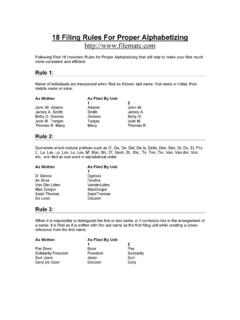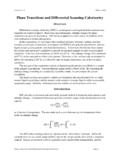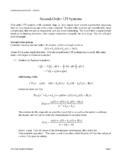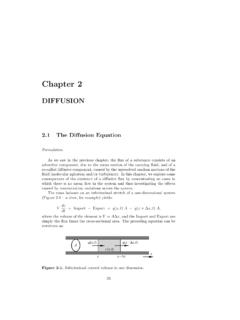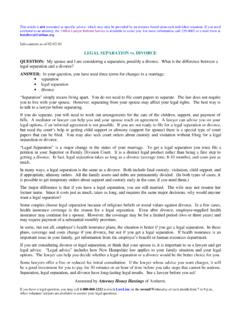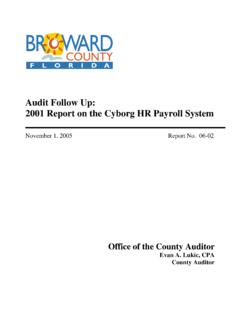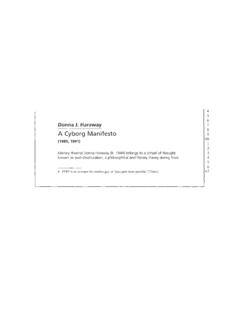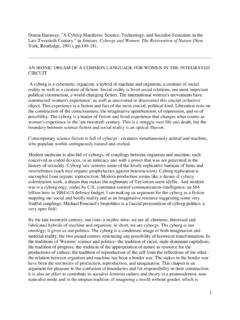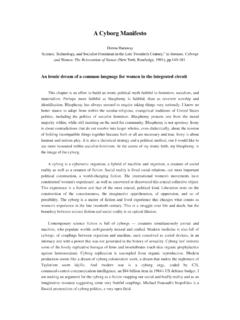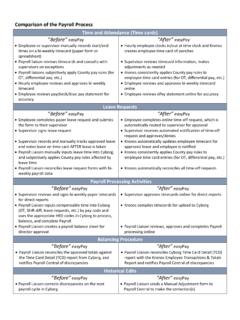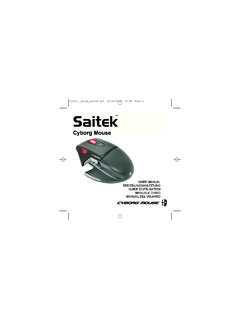Transcription of The Cyborg in Pieces: Gender Identity in Her and Ex Machina
1 2726 The Cyborg in pieces : Gender Identity in Her and Ex MachinaKatherine Emery Brown Much dialogue on artificial intelligence centers upon whether consciousness is possible in various forms of technology. Spike Jonze s Her and Alex Garland s Ex Machina present two very distinct cinematic por-traits of artificial intelligence. Both films approach the subject from the assumption that the intelligence already possesses consciousness. Thus, the issue becomes less about the capabilities of the machine and more about how the human distinguishes itself in comparison. Both films present the AIs as specifically female, assigned a Gender by their creators. The AI in Her, Samantha, is an operating system, a voice without a body. Her lack of body both limits her capacity for human interaction while simultane-ously allowing her infinite virtual possibilities.
2 Ava, the AI in Ex Machina , possesses a definitive robotic body, one that is at once recognizable as both female and machine. In this way, the distinctions between Ava and Saman-tha evoke questions of Gender Identity in relation to embodiment, not only within the two forms of AI but also within their human counterparts. The specific qualities that distinguish a human from a machine blur, particularly through the force of sexual desire. This essay considers the role of Gender in the question of how the human differentiates itself from other modes of being. In Donna Haraway s essay A Cyborg Manifesto, she identifies the Cyborg , tracing it alongside various concepts of Gender . Haraway rejects the binary model of understanding how the female distinguishes itself from the male and how the human and machine differ. Haraway defines the Katherine Emery BrownDartmouth College28 Master of Arts in Liberal Studiescyborg several times, first as a cybernetic organism, a hybrid of machine and organism, a creature of social reality as well as a creature of fiction (315).
3 She calls into question many ideological dichotomies in her essay: mind and body, animal and human, organism and (326). In so doing, Haraway draws attention to the ineffectiveness of approaching the world through a binary lens. Later in the essay she defines the Cyborg differently, as a kind of disassembled and reassembled, postmodern col-lective and personal self. This is the self feminists must code ( Manifesto 326). At the beginning of her essay, Haraway defines the Cyborg tangibly, yet the Cyborg s physicality dissolves as Haraway progresses. The Cyborg is simultaneously a collective and a self; it is the myth and meaning structur-ing our imaginations ( Manifesto 326). Haraway s description questions the completeness or wholeness of the female Identity first and foremost, as meanings of being have shifted through the very existence of the uses her exploration of the Cyborg to call attention to the frac-tured Identity of the female and its elusiveness in attaining a concrete definition.
4 She states, there is nothing about being female that naturally binds women. There is not even such a state as being female ( Mani-festo 319). For Haraway, the concept of woman should remain elusive. J. Halberstam draws upon Haraway s work in her essay Automating Gen-der: Postmodern Feminism in the Age of the Intelligent Machine. Here, Halberstam acknowledges the technological nature of Gender constructs: Gender , we might argue, like computer intelligence, is a learned, imitative behavior that can be processed so well that it comes to look natural (Hal-berstam 443). Both Haraway and Halberstam resolutely avoid a definition of Gender . In an interview with Thyrza Nichols Goodeve, Haraway, who comes from a scientific background in biology, continues to blur the lines that identify the human. She says, I have imagined how like a leaf I am.
5 For instance, I am fascinated with the molecular architecture that plants and animals share ( Leaf 132). The conceptual boundaries that distinguish the 2928human from an animal, a leaf, and a machine have blurred, making it diffi-cult to distinguish completely separate states of being. Haraway asserts that the fractured nature of being is exactly how the female derives her power, as there is a pleasure in the confusion of boundaries ( Leaf 133). The female is a Cyborg because she is assembled from different parts, a hybrid that allows her to avoid containment within a concrete definition. We are all chimeras, theorized and fabricated hybrids of machine and organism; in short, we are cyborgs . The Cyborg is our ontology ( Manifesto 315). Haraway adopts the Cyborg in order to explore the female ontology pre-cisely because it is constructed in parts.
6 In so doing she creates an actively shifting female Identity . If femininity is itself a construct rather than a nature, then the creation of the female machine calls into question its seemingly inherent qualities. In Ex Machina , when Nathan creates Ava, he perhaps attempts to stabilize the elusive definition of woman by forming an ideal replica. The film raises the problematic male view of the female through the character of Nathan. He has designed something he desperately wishes he can con-trol, but by giving her sexuality he risks this as the Cyborg s power over the male lies in her sexual desirability. Nathan says to Caleb: I don t see Ava as a decision, just an evolution. She s part of a continuum. He says this as the film moves towards his inevitable demise at the hands of his creations. Na-than s fatal mistake was in thinking that the evolution he speaks of lay solely within the transition from human to artificial intelligence.
7 This continuum exists within Gender as well, but in viewing the programming of Ava as a simple choice between binaries (male/female, gay/straight, etc.), Nathan doesn t quite realize what he has created. The infinite nature of sexual-ity allows Ava to manipulate the men and to communicate with the other AI. The cyborgs in Ex Machina , though visually seeming to conform to the female Gender binary, gain their power through the fracturing Identity for which Haraway calls. Once Ava has used her sexuality to manipulate, she Katherine Emery BrownDartmouth College30 Master of Arts in Liberal Studiesthen transitions into an existence other than that which is defined by con-ventional male desire. Ava is given the intelligence to desire outside the binary of man and not man (Gold). In a literal sense, Ava pieces herself together to look human at the end of the film, covering her robotic body in skin and clothing.
8 However these pieces do not then create a uniform whole, rather this seeming whole is an illusion, allowing Ava to retain her power in fragments. Both Caleb and Theodore, the human male protagonists in Ex Machina and Her respectively, struggle with the dissolution of Identity of which Haraway speaks: Communication processes break [as they] fail to recognize the difference between self and other ( Manifesto 327). When Caleb asks Nathan whether he programmed Ava to like him, Nathan responds: I programmed her to be heterosexual just like you were pro-grammed to be heterosexual. When Caleb challenges the idea that he was programmed Nathan replies, please, of course you were programmed, by nature or nurture or both. A programmer by profession, Caleb s inter-actions with Ava cause him to question his own Identity and body, even something as seemingly stable to him as his own sexuality.
9 By desiring Ava he identifies with her programmed body, rejecting his own corporeal body, for once Caleb has discovered that Kyoko, Nathan s submissive servant, is also an AI, he questions whether he himself could be as well. Uncovering the illusion that a seemingly human body can in fact be a machine leads Ca-leb to look in the mirror, checking and dis-identifying with his own body. He winds up slitting his wrist, perhaps in the hope of discovering that he might in fact possess an Ava-like body, bringing him closer to the object of his desire. In Her, Theodore s loss of Identity occurs differently. When the film begins, he has already dis-identified from his body and the world around him, causing him to readily and easily connect to his operating system. His disconnectedness is evident when he confesses to Samantha: 3130 sometimes I think I ve felt everything I m ever gonna feel and from here on out I m not gonna feel anything new, just lesser versions of what I ve already felt.
10 He identifies so quickly with the disembodied Samantha, and it is only by seeing the world through her eyes that he begins to come back to life. In his essay, The Gifts of Ubiquity, James J. Hodge speaks of identification operating in the realm of desire and fantasy. As Freud states, identification is not about what one would like to have but rather what one would like to be ..The conventional assumption is that one would like to be something else, that identification begins with an object of desire (58). Theodore doesn t simply desire Samantha sexually as they embark upon a romantic relationship, but his desire extends to multiple levels through the confusion of his own Identity . When asked what he loves most about Samantha, Theodore replies: what I love most about her is she isn t just one thing, she s so much larger than that.

